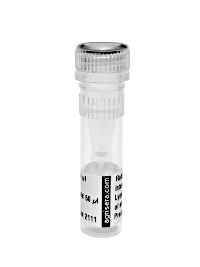1

Anti-Dehydrin (serum)
AS07 206 | Clonality: Polyclonal | Host: Rabbit | Reactivity: Higher plants
- Product Info
-
Immunogen: KLH-conjugated peptide sequence TGEKKGIMDKIKEKLPGQH of K-segment conserved in a wide range of plant species
Host: Rabbit Clonality: Polyclonal Purity: Serum Format: Lyophilized Quantity: 50 µl Reconstitution: For reconstitution add 50 µl of sterile, deionized water Storage: Store lyophilized/reconstituted at -20°C; once reconstituted make aliquots to avoid repeated freeze-thaw cycles. Please remember to spin the tubes briefly prior to opening them to avoid any losses that might occur from material adhering to the cap or sides of the tube. Tested applications: Western blot (WB) Recommended dilution: 1 : 1000 (WB) Expected | apparent MW: 9-200 kDa
- Reactivity
-
Confirmed reactivity: Agostis stolonifera cv. ‘Penncross’, Betula pubescens, Betula pendula, Betual pendula var. carelica, Hordeum spontaneum, Larix cajanderi, Malus spp., Picea obovata, Picea abies, Picea glauca, Pinus sylvestris, Pinus strobus, Pinus sylvestris, Spinacia oleracea, Triticum aestivum, Vitis vinifera
Predicted reactivity: Arabidopsis thaliana, Glycine max, Nicotiana tabacum, Pisum sativum, Hordeum vulgare, Oryza sativa, Populus sp., Zea mays
Species of your interest not listed? Contact usNot reactive in: No confirmed exceptions from predicted reactivity are currently known - Additional Information
-
Additional information (application): According to Borovskii et al. 2019, dehydrin detection level can be increased by obtaining a thermostable fraction. - Background
-
Background: Dehydrins are stress proteins involved in formation of plant protective reactions against dehydration. They are normally synthesized in maturating seeds during their dessication, as well as in vegetative tissues of plants treated with abscisic acid or exposed to environmental stress factors that result in cellular dehydration.
- Product Citations
-
Selected references: Vítámvás et al. (2021) Relationship between WCS120 Protein Family Accumulation and Frost Tolerance in Wheat Cultivars Grown under Different Temperature Treatments. Plants (Basel). 2021 May 31;10(6):1114. doi: 10.3390/plants10061114. PMID: 34073120; PMCID: PMC8228299.
Kartashov et al. (2021) Quantitative analysis of differential dehydrin regulation in pine and spruce seedlings under water deficit. Plant Physiol Biochem. 2021 Mar 3;162:237-246. doi: 10.1016/j.plaphy.2021.02.040. Epub ahead of print. PMID: 33706184.
Vazquez-Hernandez et al. (2020). Functional characterization of VviDHN2 and VviDHN4 dehydrin isoforms from Vitis vinifera (L.): An in silico and in vitro approach. Plant Physiol Biochem. 2021 Jan;158:146-157. doi: 10.1016/j.plaphy.2020.12.003. Epub 2020 Dec 4. PMID: 33310482.
Rachenko and Rachenko (2020). The variation of the content of dehydrin proteins in the bark of Malus app. trees differing in winter hardinessin Southern Cisbaikalia conditions . Zemdirbyste-Agriculture, vol. 107, No. 2 (2020), p. 185–190 DOI 10.13080/z-a.2020.107.024.
Lv et al. (2018). Characterization of Dehydrin protein, CdDHN4-L and CdDHN4-S, and their differential protective roles against abiotic stress in vitro. BMC Plant Biol. 2018 Nov 26;18(1):299. doi: 10.1186/s12870-018-1511-2.
Maszkowska et al. (2018). Phosphoproteomic analysis reveals that dehydrins ERD10 and ERD14 are phosphorylated by SNF1-related protein kinase 2.10 in response to osmotic stress. Plant Cell Environ. 2018 Oct 19. doi: 10.1111/pce.13465.
Tatarinova et al. (2018). Dehydrins in Buds of Main Birch Species under Conditions of Karelia. Russian Journal of Plant Physiol, Vol 65, Issue 2, pp 295–301.
Tatarinova et al. (2017). Dehydrin stress proteins in birch buds in regions with contrasting climate. ell and Tissue Biology, Volume 11, Issue 6, pp 483–488.
Jespersen et al. (2017). Metabolic Effects of Acibenzolar-S-Methyl for Improving Heat or Drought Stress in Creeping Bentgrass. Front Plant Sci. 2017 Jul 11;8:1224. doi: 10.3389/fpls.2017.01224. eCollection 2017. (western blot, Agostis stolonifera cv. ‘Penncross’).
Jedmowski et al. (2014). Comparative analysis of drought stress effects on photosynthesis of Eurasian and North African genotypes of wild barley. Photosynthetica, September 2014.
Kjellsen et al. (2013). Dehydrin accumulation and extreme low-temperature tolerance in Siberian spruce (Picea obovata). Tree Physiol. 2013 Dec;33(12):1354-66. doi: 10.1093/treephys/tpt105. Epub 2013 Dec 11.
Petrov et al. (2011). Woody plants of Yakutia and low-temperature stress. Russian Journal of Plant Physiology 58:1011-1019. - Protocols
-
Agrisera Western Blot protocol and video tutorials
Protocols to work with plant and algal protein extracts - Reviews:
-
Alexander Kartashov | 2020-09-01This antibody has been used with total protein from needles and roots of seedlings Scots pine (Pinus sylvestris L.) and Norway spruce (Picea abies (L.) H. Karst). 20 mg of total proteins were separated on 10% tricine-SDS-PAGE (Haider et al. 2012 (https://doi.org/10.1007/978-1-61779-821-4_8)). After transfering to membrane the blots were incubated with a primary antibody (1:1000) 12h, 4°C h. Membrane were washed and incubated with a secondary antibody (goat anti-rabbit IgG, AS09 602, Agrisera). In spruce at least six dehydrins were found, including 35, 40, 45, 55, 65 and 70 kDa dehydrins. In pine, least 3 dehydrins (45, 50, 65 kDa) were found.
Antibody showed a clear and stable reaction with samples.
The reproducibility of the result made it possible to quantification.
Alexander V. Kartashov, PhD, senior researcher
K.A. Timiryazev Institute of Plant Physiology RASVeronika Z | 2014-09-29WB was performed with probe of Pinus sp. Amount of protein on each lane - 15 ?g. Electrophoresis was conducted in 12% SDS-PAGE. Antibody dilution - 1:1000. There were observed protein bands on 60 kDa and several bands less than 30 kDa.



